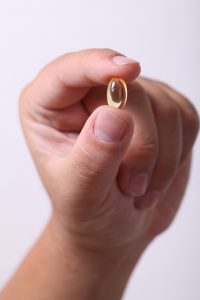THE FACTS ON MULTIVITAMINS
The jury is still out – to supplement or not – but many of us do believe that taking vitamins and minerals can help fill in the nutritional gaps that our diets don’t cover.
Mother Nature provides an incredible pharmacy through the food she gives us. When it comes to getting the essential vitamins, minerals and antioxidants that our bodies need to deal with daily life, some health professionals say that we should look no further than a natural, well rounded diet of whole foods.
Even the National Health and Medical Research Council advocates that Australians don’t need vitamin and mineral supplements, rather we can get adequate nutrients from a varied and balanced diet.
But, the opposing argument – to bridge the nutritional gap with a vitamin and mineral supplement – also makes a lot of sense.
Many healthcare professionals and all vitamin companies uphold that today, food alone won’t always guarantee adequate nutrition and is hard-won.
Obviously those who eat badly, have special nutritional needs or suffer conditions like lethargy or stress might need extra help. But some say, even the Saintly who; eat mostly organic; a seemingly perfect balance of foods and prefer wheat-grass shots over the Vodka are possibly not getting the recommended daily vitamin and mineral levels from a well-balanced diet.
Why not? Because the variations in the way it is grown, stored and prepared make nutritional values complex and we all have different needs.

Plants serve as the foundation for our food chain and the nutrients we find in unprocessed, pure food all stem from soil. Some soil, however arable, may not be nutrient-rich, causing irregularities in nutritional levels.
So, for example, because there is very little selenium in Australian soil, a banana grown in Australia is likely to be much lower in selenium than a banana grown in say Thailand.
Then there’s erosion, herbicides and pesticides and the overuse of crops: “It’s hard to measure and it is a debatable topic, but there is evidence that shows us fat soluble chemicals used in non-organic farming do destroy nutrients,” says Victoria O’Sullivan, Managing Naturopath of O’Sullivan Health Food Group.
There are also experts who disagree and say that if the soils were really that depleted the food wouldn’t grow.
Food picked too early is not filled with the level of nutrients that it could potentially provide
Once a food is taken from its source it is no longer connected to its nutritional supply affecting its nutrient density. So, for example, an apple that is picked to ripen on the supermarket shelf it is not going to be as nutritious as it would have been if left to ripen on the tree.
Food processing, storage and preparation of food at an industrial and domestic level can reduce the nutritional value of food.
Vitamins and minerals are each in their own right –
some are more sensitive than others. Vitamin C, for example, is sensitive to air, heat and water. It’s easily destroyed by prolonged storage, overcooking and processing of foods.
Many nutrients in vegetables are heat soluble, so the nutrients disappear as they cook.
Storage degrades the nutrient value in foods. It’s hard to know how long some fruit and vegetables are stored after picking and before being sold, but apparently it can be months.
We all have different nutritional needs
We are all as different on the inside as we are on the outside. Having different biological, chemical and genetic makeups means that determining a person’s nutritional needs and monitoring the vitamins and nutrients we each absorb is tricky.
Supplementing makes sense
Beyond bridging the nutritional gap that our diets may not fulfil, supplementing with a multivitamin, in particular, has been given significant kudos in bringing long terms health benefits beyond the everyday.
Findings from a study done by the Harvard Medical School recommends that all adults take vitamin supplements daily to prevent chronic disease – cardiovascular disease, neural tube defects, colon and breast cancer – to name a few.
Again in the US, The Lewin Group did a study that showed when older adults took a multivitamin every day there were huge savings to the country’s healthcare system.
But again, the true value of a multivitamin has been questioned. “Multivitamins are good for people not eating well, who are traveling and children who are fussy eaters. But are they really addressing the deficiencies in the average diet – I doubt it,” says Nutritionist, Catherine Saxelby. Everyone is different and not everyone needs to take a mix of vitamins everyday.
The Multivitamin
If you do decide to supplement you’re not alone – two in five Australians take multivitamins. If you do supplement, do it as well as – not in stead of – a nutritious diet.
Many nutrients work best in synergy and enhance the benefits of each other so a multivitamin containing a mix of vitamins, mineral and antioxidants may even be more effective than taking an individual vitamin or mineral in isolation.
Being big business, there’s no shortage in choice when it comes to the multivitamin. Our flooded market presents several hundred products each claiming to make a difference – give us more energy, protect against disease and improve our general wellbeing, to name a few claims.
Some multivitamins are ‘slow release’ to the body, enabling better absorption whilst others are ‘quick release’ for an instant uplift. Some include added enzymes, hormones, amino acids, antioxidants, herbs and phytonutrients – each with their additional benefits.
And we’re not just stuck with a tablet. Formulas are available in capsules, soft gels, powders and liquids, not to mention vitamins and mineral enhanced drinks and food bars.
There are so many choices and they appear so similar. But is there actually a lot of difference between all the multivitamin products on the market? Evidently there is.
Ingredients
Our complementary healthcare watchdog, the Therapeutic Goods Administration (TGA), is responsible for ensuring that vitamins produced in Australia are of an ‘acceptable’ standard. The TGA advocates ‘Australia has always prided itself on adopting world leading standards in the regulation of complementary medicines’ so we should, in theory, feel comfortable with what ever we buy. But as we all know it, the world isn’t perfect.
Formulas are manufactured by extracting vitamins and minerals from natural food sources and by producing synthetic versions in laboratories.
In many cases the natural derivative is, as expected, a better option. Vitamin E, for example, in its natural state is twice as effective as synthetic Vitamin E which actually blocks the natural derivative at the cellular level. And some synthetic vitamins are toxic; synthetic beta-carotene has been linked to lung cancer.
There are products on the market that are made with predominantly synthetic ingredients as well as being cheap, they are inferior to those that contain better quality, natural ingredients. Being synthetic, some vitamins can only replicate part of a beneficial nutrient.
But, natural isn’t always best when it comes to a minerals and vitamins. Although synthetic ingredients are much cheaper to produce and do not always offer the same therapeutic benefits as their natural counterparts, under controlled conditions they can work just as well as the natural ingredients. In many case, the body doesn’t in fact recognise them to be any different.
Some vitamin companies choose to use synthetic substitutes for good reason – quality, stabalising factors and ethics. Not alone, Blackmores use a synthetic version of Vitamin C because the natural derivative is particularly sensitive to processing, heating and light and it’s very difficult to capture. They also choose other synthetic alternatives where the common nutrient source is an animal product.
Dosages
The dosage of each ingredient differs significantly among brands and, not surprisingly, the dosage is often reflected in the product’s price.

Determined by the National Health and Medical Research Council in Australia, the RDI indicates what is thought to be the ‘adequate’ intake of essential nutrients for ‘all healthy people’. As everyone is different, this is a guide only and should be referred to as a baseline.
But it’s important not to go overboard and take too higher a dosage. Too much of certain nutrients can cause an overdose. If you’re unsure, see your healthcare professional for advice.
Multi Tips:
Don’t just buy any old multivitamin
Rule number one: Do your research and choose a formula that is suited to your individual needs and your pocket. If you are pregnant or planning to be, you’ll most definitely need to choose something which contains folate (B9) and that is high in iron. Keep in mind folate shouldn’t be taken in isolation; it needs B12 and B6 to work best.
Men don’t need iron like women do. In fact, too much can damage a man’s liver, which explains why most multivitamins designed for men are generally iron-free.
Cost
Quality multivitamins are easy to find but so too are their poor cousins. Steer clear of the really cheap products but remember you don’t need to spend your Christmas bonus on them either. Cost can and often does reflect quality and quantity of ingredients but it can also mean you are getting value for money so again, choose a brand you trust.
Always read the label carefully
Look for a mix of vitamins, minerals and antioxidants containing a close dosage to the RDI of each ingredient.

Take it daily
Multivitamins should be taken daily with breakfast. “Food provides the right environment for the vitamins to absorb and helps to stop nausea and vitamin B (an ingredient in all multivitamins) stimulates energy,” says Pam Stone, Naturopath, Director of Education, Blackmores.
Buying a Multivitamin

Having seen the results time and time again with patients, healthcare professional can be a good source for advice but don’t feel obliged to buy them there – some products sold this way are exactly the same as those sold directly to the consumer, just more expensive. When you’ve chosen one shop around, the savings on each purchase adds up in the long term.
More information
Complementarity Healthcare Council of Australia
Therapeutics Good Administration
Health and Medical Research Council in Australia
Australian Prescriber
Blackmores
Food Watch
O’Sullivan’s Health Foods Group
(02) 9958 6539


















